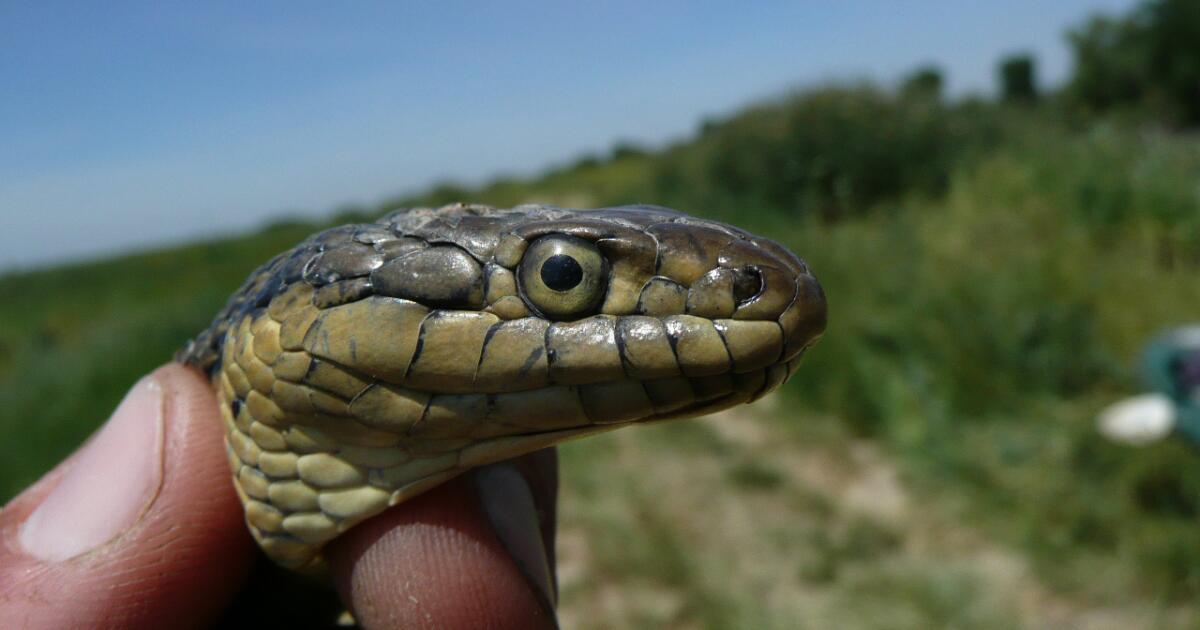Amid the slew of bills moving through the California Legislature this week, one that slithered across Gov. Gavin Newsom‘s desk was different from the others.
Though the grizzly bear has long been associated with California, its likeness is the central emblem on the state flag, with Newsom’s signature on SB 765 this week, another animal can now claim to also be an official part of the state identity: the giant garter snake.
A semi-aquatic species that is considered one of North America‘s largest native snakes, with a maximum length of 64 inches, the nonpoisonous striped snake has historically thrived in natural wetlands along California’s Central Valley, from Chico down to Fresno.
The great garner snake, held by Michael Starkey from Sacramento nonprofit Save the Snakes, is California’s new state snake.
(Save the Snakes)
Unfortunately, the giant garter snake is becoming a casualty of California’s brutal cycle of droughts and habitat destruction — as much of the Central Valley converts to agriculture or infrastructure development, according to the U.S. Fish and Wildlife Service.
It has been listed as endangered since 1993. According to SB 765, “despite efforts under these acts, the giant garter snake population has not recovered, and as California faces an uncertain future due to climate change, so does the survival of this uniquely Californian species.”
To this point, it has managed to survive by inhabiting artificial waterways like irrigation, canals and rice fields, where it became a familiar sight for local farmers, according to the U.S. Fish and Wildlife Service.
However, those artificial habitats are shifting too, as the area moves away from rice production and toward orchards and dry farmland.
The hope is the snake’s new, higher profile in California can give it a fighting chance at avoiding extinction.
“With other conservation initiatives around the world, when people learn about the wildlife in their backyard, they’ll be more inspired to take action to conserve it,” said Michael Starkey, founder of the Sacramento nonprofit Save the Snakes. “California’s K-12 curriculum teaches hundreds of thousands of students about state symbols in California, and as students learn about the species in their neighborhood, it will hopefully inspire future generations of people to care about it.”
After a multi-year campaign by Save the Snakes, state Sen. Roger Niello and the California Rice Commission, the bill was signed into law Thursday.
Starkey hopes the snake ends up like another animal that nearly went extinct but has since rebounded — Hawaii’s state bird, the Nēnē.
The native goose, with its black face and crown and its signature neck stripes, once thrived across the islands with a population of about 25,000 in the early 1800s, according to the National Wildlife Federation. However, unrestrained hunting, habitat loss and predation by the invasive mongoose left fewer than 30 in the wild by 1952. That year, the Nēnē was named the state bird, bringing more attention to conservation efforts and funding to captive breeding in order to release the bird back into the wild. Today, populations are growing with almost 4,000 living statewide in 2022.
The semi-aquatic species is considered one of North America‘s largest native snakes, with a maximum length of 64 inches. It is not poisonous.
(Save the Snakes)
Sometimes, the efforts come too late. Take the previously mentioned grizzly, California’s most well-known animal. Although once more than 10,000 grizzly bears roamed California post-Gold Rush, hunting and trapping decimated the grizzlies’ numbers, with the last sighting having been in 1924. While the animal still graces flags and emblems, it is technically extinct in California, according to the California Capitol Museum. It did not become the state animal until 1953.
The question for the giant garter snake’s future lies in whether it was saved in time.
For the humble brown reptile to rebound as successfully as the Nēnē, conservation history shows that it will take combined efforts from the state, zoo and wildlife refuges and biologists to increase numbers and preserve the state snake. Climate warming, erosion and destructive habitat practices may also lead to its continued decline.
“It’s a species that is near and dear to me personally, I’m a wildlife biologist myself and I work with the species, and saw a tremendous amount of support from biologists and farmers in wanting to recognize this snake,” Starkey said. “One of its greatest problems is that no one knows about it.”
